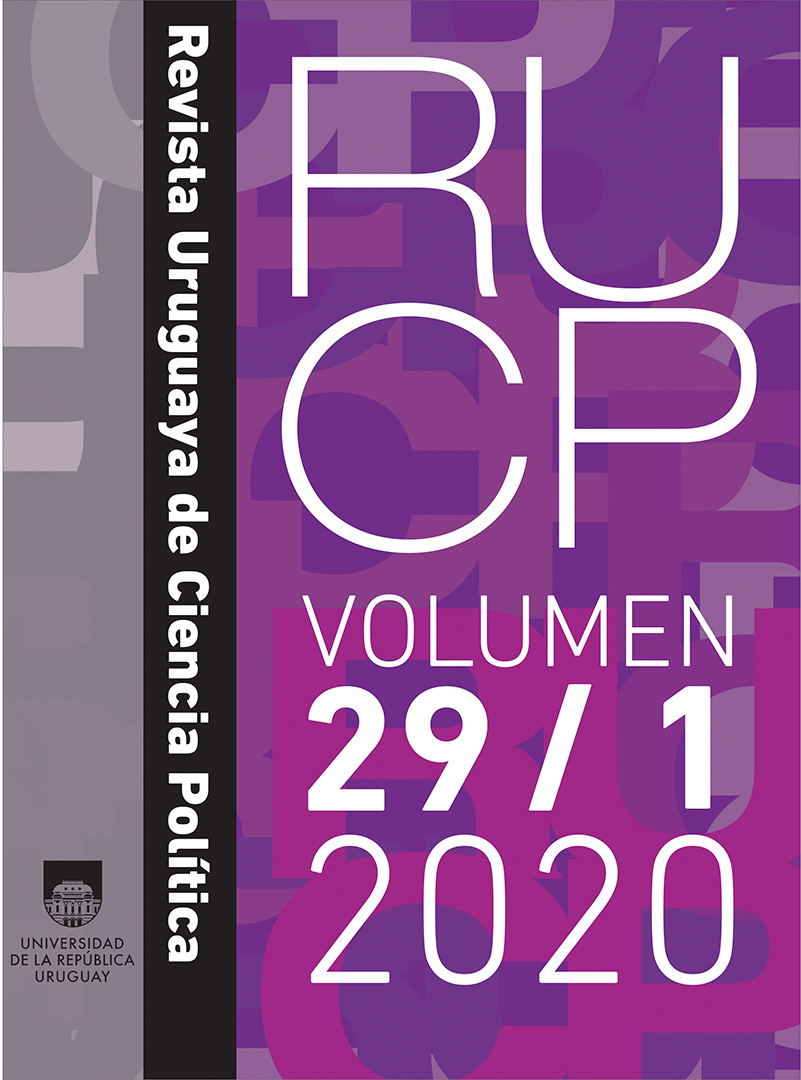High Courts and Social Media in Latin America
Keywords:
constitutional and supreme courts, institutional legitimacy, social mediaAbstract
In this article we take a first step towards understanding the use of social media by constitutional and supreme courts in Latin America. Some Latin American courts stand out worldwide for their active online presence. We present the first comparative evaluation of the social media presence of 17 Latin American high courts. We evaluate the intensity of the current use of the most relevant online platforms – Twitter, Facebook and YouTube – and explore the level of influence each court has developed in these networks. As a result, we present a classification of the courts that emphasizes that there are performance differences: the most influential courts are not necessarily the most active ones, but they make a very differentiated use of social media. In contrast, the least influential ones show great dispersion around the level of activity. Additionally, we present a preliminarily evaluation of the relationship between the level of trust in the judiciaries and both the intensity of the use and the level of influence of courts in social networks. We see that courts with higher levels of distrust are moderately more active and tend to have less influence. Two motivations could explain the court behavior in social media: First, the search for strategic self-promotion. Second, an ideal of institutional transparency.
Downloads
References
Bareiro de Módica desiste de inconstitucionalidad. (23 de julio de 2019). ABC Color. Recuperado de <https://bit.ly/2LwHrBH>.
BARRERA, L. (2013). Performing the Court: Public Hearings and the Politics of Judicial Transparency in Argentina. Political and Legal Anthropology Review, 36(2), 326-340.
BASABE-SERRANO, S. (2015). Informal Institutions and Judicial Independence in Paraguay, 1954–2011. Law & Policy, 37(4), 350-378.
BENESH, S. (2006). Understanding Public Confidence in American Courts. The Journal of Politics, 68(3), 697-707.
BRICKER, B. (2016). Vision of Judicial Review. A Comparative Examination of Courts and Policy in Democracies. Colchester, Reino Unido: ECPR Press.
BRUNS, A. (2019). After the ‘APIcalypse’: Social Media Platforms and their Fight against Critical Scholarly Research. Information, Communication & Society, 22(11), 1544-1566.
CALDEIRA, G. (1986). Neither the Purse nor the Sword: Dynamics of Public Confidence in the Supreme Court. American Political Science Review, 80(4), 1209–1226.
CALDEIRA, G., y GIBSON, J. L. (1992). The Etiology of Public Support for the Supreme Court. American Journal of Political Science, 36(3), 635–664.
CORPORACIÓN LATINOBARÓMETRO (2018). Informe 2018. Santiago de Chile, Chile: Corporación Latinobarómetro.
DAVIS, R., y TARAS, D. (2017). Justices and Journalists: The Global Perspective. Cambridge, Reino Unido: Cambridge University Press.
DE FINE LICHT, J., NAURIN, D., ESAIASSON, P., y GILLJAM, M. (2014). When Does Transparency Generate Legitimacy? Experimenting on a Context‐Bound Relationship. Governance, 27(1), 111-134.
DRISCOLL, A., y NELSON, M. (2018). There is no Legitimacy Crisis: Support for Judicial Institutions in Modern Latin America. Revista SAAP, 12(2), 361-377.
EASTON, D. (1975). A Re-Assessment of the Concept of Political Support. British Journal of Political Science, 5(4), 435-457.
EPSTEIN, L., y KNIGHT, J. (1998). The Choices Justices Make. Washington, DC, EE. UU.: CQ Press.
FALCAO, J., y DE OLIVEIRA, F. L. (2013). O STF e a agenda pública nacional: de outro desconhecido a supremo protagonista? Lua Nova, 88, 429-469.
FERREIRA, M. (22 de octubre de 2018). La Corte ante el desafío de actuar con total transparencia. ABC Color. Recuperado de <https://bit.ly/2y3QqqT>.
GARGARELLA, R. (2015). Deliberative Democracy, Dialogic Justice and the Promise of Social and Economic Rights. En H. Alviar García, K. Klare, y L. Williams (Coords.), Social and Economic Rights in Theory and Practice: Critical Inquiries (pp. 105-120). Londres, Inglaterra: Routledge.
GAROUPA, N., y GINSBURG, T. (2015). Judicial Reputation. A Comparative Theory. Chicago, Londres, EE. UU., Inglaterra: University of Chicago Press.
GIBSON, J. (2012). Electing Judges. The Surprising Effects of Campaigning on Judicial Legitimacy. Chicago, Londres, EE. UU., Inglaterra: University of Chicago Press.
GIBSON, J. (2016). Reassessing the Institutional Legitimacy of the South African Constitutional Court: New Evidence, Revised Theory. South African Journal of Political Studies, 43(1), 53-77.
GIBSON, J., y CALDEIRA, G. (2003). Defenders of Democracy? Legitimacy, Popular Acceptance, and the South African Constitutional Court. Journal of Politics, 65(1), 1-30.
GIBSON, J., y CALDEIRA, G. (2009). Knowing the Supreme Court? A Reconsideration of Public Ignorance of the High Court. The Journal of Politics, 71(2), 429-441.
GIBSON, J., CALDEIRA, G., y BAIRD, V. (1998). On the Legitimacy of National High Courts. American Political Science Review, 92(2), 343-358.
GLOPPEN, S. (2004). The Accountability Function of the Courts in Tanzania and Zambia. En Gloppen, S., Gargarella, R. y Skaar, E. (Coords.), Democratization and the Judiciary. The Accountability Function of Courts in New Democracies (pp. 112-136). Londres, Inglaterra: Frank Cass.
HILBINK, L. (2012). The Origins of Positive Judicial Independence. World Politics, 64(4), 587-621.
HOLTZ-BACHA, C. (2017). The Federal Constitutional Court and the Media. En R. Davis, y D. Taras (Coords.), Justices and Journalists: The Global Perspective (pp. 101-118). Cambridge, Reino Unido: Cambridge University Press.
INGRAM, M. (2017). Uncommon Transparency: the Supreme Court, Media Relations, and Public Opinion in Brazil. En R. Davis, y D. Taras (Coords.), Justices and Journalists: The Global Perspective (pp. 58-80). Cambridge, Reino Unido: Cambridge University Press.
KEARNEY, M. W. (2019). rtweet: Collecting Twitter Data. R package version 0.6.9, <https://cran.r-project.org/package=rtweet>.
LANDAU, D. E. (2015). Beyond Judicial Independence: The Construction of Judicial Power in Colombia (tesis doctoral). Harvard University, EE. UU.
LLANOS, M., TIBI WEBER, C., HEYL, C. y STROH, A. (2016). Informal Interference in the Judiciary in New Democracies: a Comparison of six African and Latin American Cases. Democratization, 23(7), 1236-1253.
POU-GIMÉNEZ, F. (2017). Changing the Channel: Broadcasting Deliberations in the Mexican Supreme Court. En R. Davis, y D. Taras (Coords.), Justices and Journalists: The Global Perspective (pp. 209-234). Cambridge, Reino Unido: Cambridge University Press.
RUÍBAL, A. (2009). Self-Restraint in Search of Legitimacy: The Reform of the Argentine Supreme Court. Latin American Politics and Society, 51(3), 59-86.
SALZMAN, R., y RAMSEY, A. (2013). Judging the Judiciary: Understanding Public Confidence in Latin American Courts. Latin American Politics and Society, 55(1), 73-95.
SCRIBNER, D. (2017). Judicial Communication: (Re)Constructing Legitimacy in Argentina. En R. Davis, y D. Taras (Coords.), Justices and Journalists: The Global Perspective (pp. 14-38). Cambridge, Reino Unido: Cambridge University Press.
SEGAL, J., y SPAETH, H. (1993). The Supreme Court: The Attitudinal Model. Nueva York, EE. UU.: Cambridge University Press.
Sesiones son públicas. (26 de noviembre de 2018). ABC Color. Recuperado de <https://bit.ly/3bzQaxx>
STATON, J. K. (2010). Judicial Power and Strategic Communication in Mexico. Nueva York, EE. UU.: Cambridge University Press.
TARAS, D. (2017). Introduction: Judges and Journalists and the Spaces in Between. En R. Davis, y D. Taras (Coords.), Justices and Journalists: The Global Perspective (pp. 1-13). Cambridge, Reino Unido: Cambridge University Press.
TIBI WEBER, C. y LLANOS, M. (2016). Between Independence and Control: Recent Developments within the Judiciary in Latin America. En V. González-Sánchez (Coord.), Economy, Politics and Governance: Challenges for the 21st Century (pp. 101-115). Nueva York, EE. UU.: Nova Science Publishers.
WELLS, M. (2007). ‘Sociological Legitimacy’ in Supreme Court Opinions. Washington and Lee Law Review, 64(3), 1011–1070.
WORLD BANK. (2018). World Development Indicators. The World Bank Group.



























